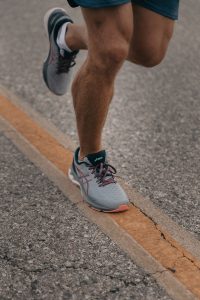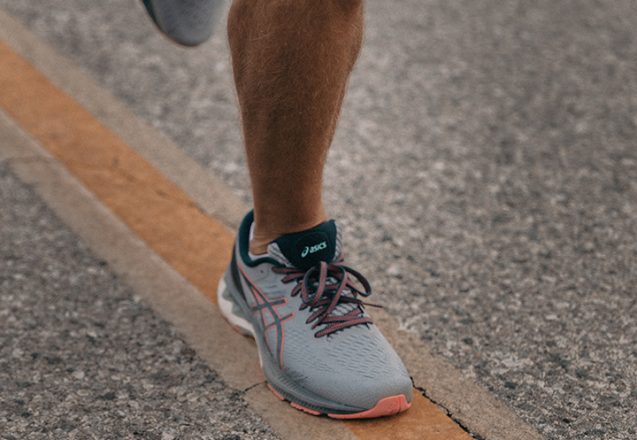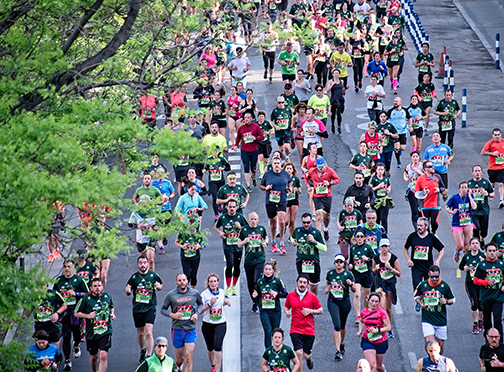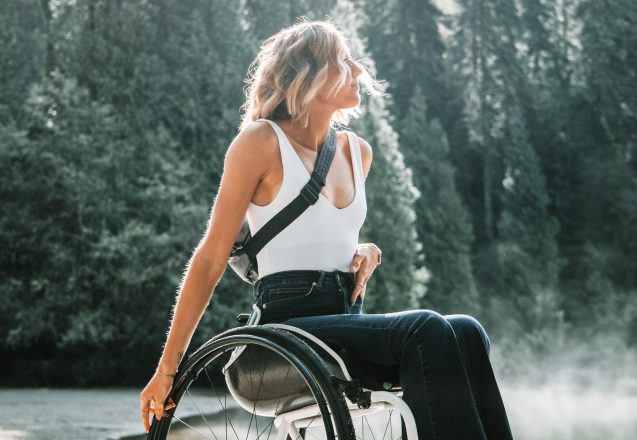Improve Your Running Technique And Avoid Injury
 Many people at Rising Fitness in Houston, TX, stay active and exercise on their day away from the gym. They might walk, dance, or bike on their days away to boost their progress. One popular exercise is running. It’s exhilarating and fun to compete against yourself for distance or time. They can experience problems if their running technique needs help. Those issues can affect their health and ability to do their regular exercise program. When you improve your running technique, you can avoid injury.
Many people at Rising Fitness in Houston, TX, stay active and exercise on their day away from the gym. They might walk, dance, or bike on their days away to boost their progress. One popular exercise is running. It’s exhilarating and fun to compete against yourself for distance or time. They can experience problems if their running technique needs help. Those issues can affect their health and ability to do their regular exercise program. When you improve your running technique, you can avoid injury.
Your posture plays a big role no matter what your fitness routine is.
Whether you’re lifting weights or running, good posture is vital. Good running posture allows the body to work more efficiently. If you have a desk job, you spend long hours sitting. It can deteriorate your posture and cause rounded shoulders with hips flexed. That creates tight hip flexors and causes other muscles to weaken. That affects you when you run. Your body needs to have the ability to flex fully, but your posture doesn’t allow it. It only allows you to run with your hips in a semi-flexed position. Do hip flexor exercises to help with an anterior pelvic tilt.
Check your stride.
People who workout regularly are often surprised at how sore or tired they get when they begin a new fitness regimen. Running is just that. Just like any fitness routine, you need to focus on your form. If you’ve been running for a while, pull back a bit and identify areas where you can improve your form. Avoid over-striding. Your knee should be flexing right above the ankle when contact is made. If you can see your ankle ahead of your knee, you’re over-striding. It helps to increase your stride frequency. It encourages your body to make the stride shorter.
Improve your core strength.
A strong core improves your stability and balance. That reduces the potential for injury. Improve your glutes. Both muscle groups directly affect your running. They help maintain lower body stability. Muscle imbalances and weaknesses can cause hip, back, and knee injuries. It can affect lower leg muscles while you run. Our trainers can help you build core strength with a personalized routine.
- Learn proper breathing techniques. Your breathing pattern should match your running rhythm. Breathe in through both your mouth and nose simultaneously. Take full breaths to maximize your oxygen intake.
- Focus on your body as you run. Run in a straight line. Don’t rotate your body from side to side as you run. It slows forward movement and depletes energy.
- Find the perfect cadence. If the cadence is too slow, it causes over-striding and bouncing. You want to reduce any bounce. If you bounce one extra inch in a marathon, it’s like adding one extra mile.
- Keep your upper body tension at a minimum so you can swing your arms easily to maintain power, balance, and rhythm. Your arm motions should match your speed. The faster you run, the bigger your arm motion should be.
For more information, contact us today at Rising Fitness Gym



 When you’re training for a marathon, you’re attempting to get the maximum endurance from your body. It takes stamina and the best training to go the distance. It is even harder to go fast enough to win. One of the best tips for training is being consistent. You won’t improve if you train a lot in one week and do nothing the next. Finding the right blend for your routine that leaves you feeling good and one you enjoy is the best way to ensure you’re consistent.
When you’re training for a marathon, you’re attempting to get the maximum endurance from your body. It takes stamina and the best training to go the distance. It is even harder to go fast enough to win. One of the best tips for training is being consistent. You won’t improve if you train a lot in one week and do nothing the next. Finding the right blend for your routine that leaves you feeling good and one you enjoy is the best way to ensure you’re consistent.
 People who focus on a particular sport frequently only train the muscles used in that sport. There are benefits to adding cross-training. When you cross-train, you use other types of exercise besides your sport. If you’re a runner, foot or baseball player, or cycler, cross-training gives you unlimited ways to train when the weather is foul and training outdoors is limited.
People who focus on a particular sport frequently only train the muscles used in that sport. There are benefits to adding cross-training. When you cross-train, you use other types of exercise besides your sport. If you’re a runner, foot or baseball player, or cycler, cross-training gives you unlimited ways to train when the weather is foul and training outdoors is limited.
 Getting fit and living a healthy lifestyle involves more than being active and eating healthy. A good mental attitude, staying hydrated, and avoiding overindulgence in alcohol are important. You also must prioritize sleep. Most people understand how mental attitude and eliminating unhealthy substances help but fail to identify where adequate sleep is part of the picture. We’re a country that honors burning the candle at both ends. Sleep is vital to recovery and part of the process of building muscles. Without adequate sleep, you’ll never see the results you want.
Getting fit and living a healthy lifestyle involves more than being active and eating healthy. A good mental attitude, staying hydrated, and avoiding overindulgence in alcohol are important. You also must prioritize sleep. Most people understand how mental attitude and eliminating unhealthy substances help but fail to identify where adequate sleep is part of the picture. We’re a country that honors burning the candle at both ends. Sleep is vital to recovery and part of the process of building muscles. Without adequate sleep, you’ll never see the results you want.
 An injury can put your workout program on tilt. People in Houston, TX, often believe that rest and avoiding exercise is the best solution for healing or whether modifying their workout to accommodate the injury is okay. The good news is that exercise helps injuries heal. There’s no reason not to do it. You won’t want to run on a broken ankle, but that doesn’t mean you can’t sit and lift weights. If you sprained your wrist, it shouldn’t stop you from walking, running, or doing squats. Be more mindful of the muscles you use when you workout with an injury, but it’s worth it.
An injury can put your workout program on tilt. People in Houston, TX, often believe that rest and avoiding exercise is the best solution for healing or whether modifying their workout to accommodate the injury is okay. The good news is that exercise helps injuries heal. There’s no reason not to do it. You won’t want to run on a broken ankle, but that doesn’t mean you can’t sit and lift weights. If you sprained your wrist, it shouldn’t stop you from walking, running, or doing squats. Be more mindful of the muscles you use when you workout with an injury, but it’s worth it.
 One of the many benefits of outdoor workouts is avoiding pollution. It’s also one of the dangers. Pollution can trigger respiratory disease and allergies. On average, air quality is better outdoors and less polluted than indoors. Indoor air pollutants are two to five times more than they are outside. The more greenery you have, the less prone you’ll be to respiratory disease. The more greenery there is, the better the air quality. The danger arises when air quality outside is poor. Air quality alerts tend to occur in crowded cities with less greenery.
One of the many benefits of outdoor workouts is avoiding pollution. It’s also one of the dangers. Pollution can trigger respiratory disease and allergies. On average, air quality is better outdoors and less polluted than indoors. Indoor air pollutants are two to five times more than they are outside. The more greenery you have, the less prone you’ll be to respiratory disease. The more greenery there is, the better the air quality. The danger arises when air quality outside is poor. Air quality alerts tend to occur in crowded cities with less greenery.
 Mindfulness is an awareness of the present moment, leaving the past in the past and not fretting on the future. Many yoga exercises and breathing techniques promote mindfulness. Those poses—asanas—and techniques also build strength, flexibility, balance, and endurance. The physical movements during yoga provide the same benefits as all exercises. Increasing focus and relaxation improve brain functioning.
Mindfulness is an awareness of the present moment, leaving the past in the past and not fretting on the future. Many yoga exercises and breathing techniques promote mindfulness. Those poses—asanas—and techniques also build strength, flexibility, balance, and endurance. The physical movements during yoga provide the same benefits as all exercises. Increasing focus and relaxation improve brain functioning.
 Whether bedridden, chairbound, or using crutches, reduced mobility doesn’t eliminate the need to exercise. Reduced mobility can be due to frailty, balance issues, or other physical problems. It doesn’t why you have limited movement, exercising is vital. If the situation is temporary, maintaining your endurance and muscle mass speeds recovery and back to your active lifestyle. Whether temporary or permanent, exercise helps you stay healthier and improves your endurance and self-reliance. Never start an exercise program without checking with your healthcare professional.
Whether bedridden, chairbound, or using crutches, reduced mobility doesn’t eliminate the need to exercise. Reduced mobility can be due to frailty, balance issues, or other physical problems. It doesn’t why you have limited movement, exercising is vital. If the situation is temporary, maintaining your endurance and muscle mass speeds recovery and back to your active lifestyle. Whether temporary or permanent, exercise helps you stay healthier and improves your endurance and self-reliance. Never start an exercise program without checking with your healthcare professional.
 Eggs are an inexpensive source of protein and chock-full of nutrients. Go to any restaurant in Houston, TX, and you’ll find a variety of egg dishes on the menu. They’re nutrient-dense and low-calorie. You can eat them at every meal. Unfortunately, eggs suffer from bad PR and inaccurate science. There are myths about the dangers of eating too many eggs and how they negatively affect your health. Nothing could be further from the truth.
Eggs are an inexpensive source of protein and chock-full of nutrients. Go to any restaurant in Houston, TX, and you’ll find a variety of egg dishes on the menu. They’re nutrient-dense and low-calorie. You can eat them at every meal. Unfortunately, eggs suffer from bad PR and inaccurate science. There are myths about the dangers of eating too many eggs and how they negatively affect your health. Nothing could be further from the truth.
 Food journals are helpful in several situations. If you’re trying to shed a few extra pounds, it can be eye-opening. You’ll be more aware of what you eat and when you eat so you can take steps to prevent it. If you’re constantly having digestive issues or other health issues and the doctors are stumped, a food journal can help. Add extra information to get the results, such as how you feel. You can make your food journal simple with just the food you eat.
Food journals are helpful in several situations. If you’re trying to shed a few extra pounds, it can be eye-opening. You’ll be more aware of what you eat and when you eat so you can take steps to prevent it. If you’re constantly having digestive issues or other health issues and the doctors are stumped, a food journal can help. Add extra information to get the results, such as how you feel. You can make your food journal simple with just the food you eat.